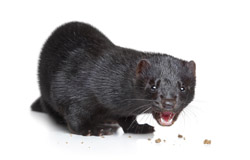Protecting Europe’s wildlife from mink
The 'Invasive predator control: response of American mink to eradication in relation to farm distribution' (Minkcontrol) project was established to counter the highly invasive species. Total removal of N. vison is not always possible; however, it can be controlled enough to allow native wildlife to survive.Minkcontrol examined the animal’s encroachment into national parks in northeast Poland to help protect vulnerable waterfowl from predation. Controlling an invasive species requires information regarding its spread and population structure. Scientists therefore studied the genetic diversity of feral and farm mink to better understand the colonisation process. This included the possible influence of new animals on Poland’s feral mink population. Studies revealed that established wild populations of American mink populations were not the same genetically, but made up of feral mink and farm mink. The distribution of the feral populations showed some regional distribution, together with other factors that shaped the animal’s genetic structure. Findings also indicated that the proportion of feral mink that had escaped from fur farms corresponded to the size of breeding stocks in districts where sites were located. This demonstrated that escapees from farms could significantly supplement local populations of feral mink. Analyses of mitochondrial DNA revealed significant genetic differences among feral mink from separate trapping sites, whilst differences among farm mink from various farms were less pronounced. The number of trapping sites where given DNA sequences were found correlated with the number of farms with the same sequences. Project partners concluded that the colonisation process was caused by numerous escapees from various Polish fur farms and by immigrants from Belarus. Therefore, the genetic structure of local feral mink populations was the result of multiple introductions and mink’s ability to widely disperse. A possible outcome could be that the mixing of different populations has improved the ability of individuals to survive, thereby increasing the invasiveness of the species. As such, the work of Minkcontrol and similar projects is crucial in helping to understand how best to eradicate American mink and preserve Europe’s native species and biodiversity.







